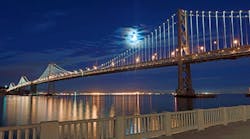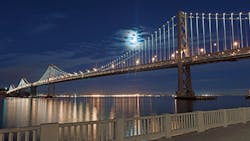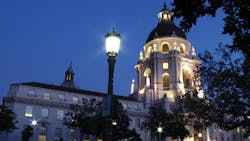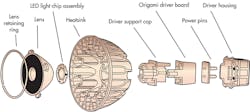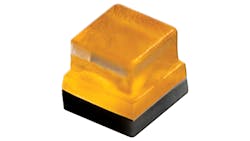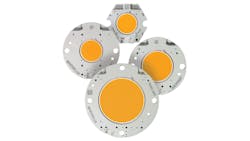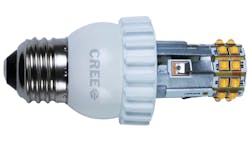This file type includes high resolution graphics and schematics.
The use of solid-state LED light bulbs is catching on, driven by better performance and lower costs. This is particularly obvious in the commercial and industrial sectors as well as in outdoor and infrastructure lighting. Despite their initially higher upfront costs compared to existing lighting solutions like incandescent and fluorescent bulbs, LEDs are proving to be more cost-effective and providing greater energy savings in the long run.
By most estimates, non-residential locations like manufacturing plants, business offices, commercial buildings, and infrastructure and other outdoor facilities account for half or more of all the energy consumed by lighting. Many governments and companies worldwide are taking measures through funding to help reduce this energy usage through the use of more efficient LED bulbs and fixtures.
Related Articles
• Understanding LED Application Theory And Practice
• First GaN-on-Silicon LEDs Commercially Available
• LEDs Line Up To Replace Residential Incandescents
The United Kingdom’s Energy Efficient Financing (EEF) scheme for non-residential users covers upfront costs of lighting equipment, with repayments over time aligned with lower energy-saving utility bills. The EEF was started under the U.K.’s Carbon Trust and Germany’s Siemens Financial Services Ltd.
Cash for Clunkers, a supplier of Eagle LED lighting tubes in Philadelphia, Pa., is spurring its customers to save up to 50% more energy by reimbursing a portion of what their present T12 fluorescent bulbs are worth. The company also is covering the cost of their removal and the new installations.
A Wide Range Of Applications
LED bulbs are widely used for infrastructure (bridges, tunnels, street lighting, highways), stadiums, parking lots, airports, and events. For example, they were prominent in the commemoration of the 25th anniversary of the iconic San Francisco Bay Area Bridge with what the event’s organizers called the world’s largest light sculpture. The project involved more than 25,000 LED bulbs from Philips Semiconductor, installed on the suspension cables stretching 1.8 miles on the western span of the bridge and reaching heights of 500 feet (Fig. 1).
LED lighting is also prominent in historic and municipal structures. LEDtronics employs its post-top LED lamps to illuminate City Hall in Pasadena, Calif., as part of the city’s plan to replace all of its much higher-dissipation metal-halide bulbs (Fig. 2). Pasadena is one of the early cities that signed on to the U.S. Conference of Mayors Climate Control Agreement in 2005 to reduce energy waste, cut maintenance costs, and promote a greener environment.
LED lighting is also growing in automotive and consumer electronics display backlighting applications. Edge lighting for digital signage is getting more popular too. Strategies Unlimited projects the $13.7 billion LED worldwide component market to grow to $16.4 billion by 2017, at a compound annual growth rate of 3.7%. Lighting constitutes the largest growth sector of the market. Solid-state lighting LED lighting is an international trend as well, with China aiming to be a major player (see “China Emerges In The LED Market”).
The U.S. government’s estimate for future growth of LED light bulbs of all types is telling. The Energy Information Administration estimates that total sales of all light bulbs, LEDs included, will fall by 40% by 2015, with LEDs making up a continuing larger portion of the total market. This is because LEDs will last longer once installed, so users won’t have to change them as often in subsequent years.
This file type includes high resolution graphics and schematics.
Growth in the consumer and home markets is picking up speed, but at a slower rate than the commercial sector. Major LED bulb manufacturers like Philips, Osram Semiconductor, and General Electric (GE) as well as mass-market retailers like the Home Depot, Lowe’s, Wal-Mart, and Best Buy are aggressively taking advantage of lower initial costs, offering low-cost LED light bulbs to make them more attractive and appealing to home owners.
A 40-W equivalent LED light bulb like the EcoSmart at the Home Depot now can be had for about $10. Philips is offering a three-pack set, the Hue, at Apple Computer facilities as part of a kit that includes hardware and software. For about $200, the Hue kit lets users control their lights including color changes via their tablets and smart phones.
Major LED bulb makers like Cree Lighting and Philips Lighting are offering consumers looking to retrofit their lamps 60-W equivalent A-lamp LED light bulbs for less than $15. Cree’s bulbs offer omnidirectional light distribution and include dimming support. They range in price from $9.97 (6-W equivalent 450-lm 2700K bulb) to $13.97 (60-W equivalent 800-lm 5000K bulb) (Fig. 3). Philips is offering LED bulbs for $14.97 (60-W equivalent 800-lm 3000K bulb) without the dimming capability.
Better Performance
Brighter and higher-efficacy LED light bulbs continue to emerge. Light-output and efficacy levels are effectively doubling every six months. Philips Lighting’s Luxeon S emitter LEDs deliver the highest luminous density and the best center-beam candle power on the market. At twice the lumen density of existing offerings, the second-generation illumination-grade multi-chip emitters offer an R9 value (R9 is a measure of the color-rendering index, or CRI) that exceeds 80 and has a 50% better color over angle figure compared to other LED bulbs. Designed for architectural and entertainment applications, they deliver 50 lm/mm2 and a light output of up to 8000 lm in narrow beams with sharp shadows.
Correlated color temperatures (CCTs) now range from 2700K to 6500K with CRI values ranging from 70 to 95. So, LEDs now can be used for a broader range of applications. Luminous LED efficacy is also on the rise. Many LED semiconductor manufacturers regularly obtain efficacies in the 100- to 160-lm/W range.
Cree just broke the 10,000-lm barrier with an expanded family of integrated LEDs that deliver the industry’s highest-efficacy lighting class arrays. The CXA2540 and CXA3050 LEDs deliver 5000 to more than 10,000 lm, enabling high track lights and downlights, outdoor area lighting, and high bay lighting.
Some experts say that 200-lm/W efficacies can be reached by 2016. Cree Lighting achieved higher efficacy levels in the lab a couple of years ago. The company now claims that it has achieved 276 lm/W from a white LED bulb in an R&D setting.
Lifetimes for LED bulbs are also improving to 50,000 hours or more, a benchmark set by the U.S. Department of Energy (DoE) for commercially available LED bulbs. 3M plans to sell 450-lm 40-W and 60-W equivalent LED light bulbs at Wal-Mart with a 25-year lifetime for $25. The key is the use of the company’s multi-layer optical film, adhesives, and clever thermal management that allows the bulb to dissipate just 8.5 W.
Gallium-nitride (GaN) on GaN technology also forebodes well for the future of LED performance. Soraa has demonstrated that GaN on GaN can handle significantly more current and emit 10 times more light per unit area than conventional LEDs. Last year, the company demonstrated a 12-V ac MR16 lamp with integral drivers that operates with several combinations of transformers and dimmers. The standard 2700K and 3000K versions boast a CRI of 80. A high-CRI version of 95 won the prestigious Red Dot Award (Fig. 4).
An alternative lighting method, induction lighting, offers longer lifetimes (up to 100,000 hours), lower maintenance costs, superior lumen maintenance (70% output at 60,000 hours), better color matching, and greater energy savings than LEDs. Like a fluorescent bulb, an induction bulb uses mercury in a gas that’s inside the bulb. It doesn’t use electrodes to strike the arc and initiate current flow, though, so it’s arc-less. A high-frequency generator with a power coupler produces an RF magnetic field that excites the gas.
This file type includes high resolution graphics and schematics.
Induction lighting provides a maximum return on investment for applications where bulbs are difficult to access and change, resulting in lower overall maintenance costs. However, they cannot be focused on a spot or area (due to the nature of the bulb’s operation) and aren’t fully dimmable.
MHT Lighting provides induction lighting with its patented A-19 induction light bulbs and fixtures for indoor, outdoor, and roadway applications in various forms like domes, bars, strips, and custom formats. It also offers LED lighting fixtures where the application calls for them. MHT is the design and manufacturing arm of PMI. In keeping with PMI’s focus on energy savings, it uses PMI’s SP1000 hybrid energy management and correction system (see “Intelligent Energy Optimization System Slashes Large-Scale Electric Bills”).
One of the most important parameters governing LED light bulb performance and lifetime is how it is driven. The implementation of the right driver circuit, thermal management, dimming control, and reliability are all key elements in an LED light bulb’s success (see “Understanding LED Application Theory And Practice”).
More Forms For Greater Flexibility
To compensate for different design life cycles for LED chips and illumination end products, chip manufacturers are packaging their die into various forms for greater end-user flexibility. Some packaging options combine a chip-on-board (CoB) arrangement, where several LED die are clustered to form a round shape that provides optimal efficiency and light quality. Most LED light sources are rectangular and square and covered by a lens or plastic coating.
Solid-state lighting uses various LED form factors like strips, straight and angled bars, canopies, modules, domes, track lights, light sticks, pucks, and troffers to make for more interesting and appealing lighting solutions. For example, the LED modules in the XSM family from Xicato produce 3000 lm for brighter and more efficient illumination.
Of course, packaging several die in a small enclosure involves careful thermal management with heatsinks and other techniques, which many chip makers are offering with their die. This is particularly true for some applications like automotive exterior lighting that cannot tolerate designs that take up more space like fans and cooling systems. Thermal-interface materials that work with the LED’s substrate are finding favor.
“There’s more to LED lighting than meets the eye,” says Arunava Dutta, director of R&D LED Lamps, Americas, General Lighting, at Osram Sylvania. “A good knowledge is needed in chemistry, colorimetry, optics, mechanical issues, thermal management, and a host of other sciences to optimally design a lighting fixture. Ultimately, everything shows up in the lm/W number.”
Sylvania says it has designed very lightweight LED lamps in PAR20, PAR30, and PAR38 form factors that weigh one-fourth the weight of conventional retrofit fixtures, thanks to very good thermal management and advanced integrated driver circuitry.
A new packaging technology allows Bridgelux to produce LED chips that increase luminous output by 20% but at the same power level. Vero employs modular connectors and other design innovations to make it easier to create lighting fixtures, leading to a greater variety of fixtures at lower price points (Fig. 5).
Cree’s XLamp ceramic-based XQ LEDs feature a unique combination of small size, novel light distribution, and high-reliability design to enable applications that require broader light distribution such as omnidirectional lamps and fixtures (Fig. 6). The company’s upgraded LEDway series of LED streetlights offers a 20% additional energy savings over previous versions and improved luminous output.
Software Tools Ease Designs
Software is becoming an indelible tool for making the design of LED bulbs and fixtures more flexible and simpler. The WEBENCH Designer tool suite from Texas Instruments includes powerful software algorithms and visual interfaces that deliver complete power, lighting, and sensing applications in seconds.
“This is one tool that vastly simplifies the complexity of LED-based designs, especially for newer designers,” explains John Perry, TI’s product marketing manager for lighting and power products.
The LightTools software tool suite from Synopsys Corp. is an illumination design environment that integrates 3D CAD, optical modeling, and an interactive user interface to simplify the design of illumination applications, including LED die packaging and LED-driven illumination systems.
Smarter Lighting
LED lighting technology will make its mark on society through greater intelligence and more connectivity, a trend that has already begun. Speaking at last year’s Street and Area Lighting Conference (SALC), keynote speaker Niels Van Duinen, global marketing director at Philips Lighting, said that “adaptive control can bring energy savings up to 80% through the use of smarter LEDs.” He foresees solutions on unified networks connecting street and other infrastructure lighting that offers greater user control through using Internet protocol (IP) communications.
Redwood Systems helps lighting fixture developers achieve smart LED lighting through sensing and driving innovations. “We put three sensors in each lighting fixture in a pod: an infrared (IR) sensor for motion detection, a temperature sensor, and an ambient light detector, allowing the user to cut down on unnecessary waste of power, like when no one is in a room, an office is not occupied, a plant is idle, and a building’s heating ventilating and air conditioning (HVAC) is not in a peak demand time,” says Marco Sciorelli, Redwood’s head luminaire specialist.
“These sensors are all standard readily available parts,” adds Derek Anderson, vice president of marketing at Redwood.
This file type includes high resolution graphics and schematics.
